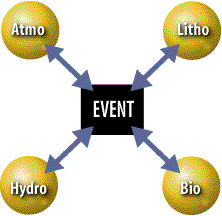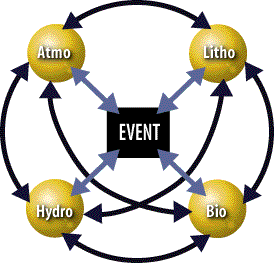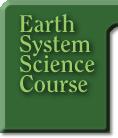What Is Earth System Science?
A
system is a collection of individual parts that work together as a complex
whole. For example, the human body is a system made up of many parts
called organs. Organs, such as the heart, stomach, and lungs, work
together so that a human can live.
Earth is also a system. It
consists of four major parts called "spheres." Earth's
spheres include:
- the lithosphere, which
contains all of the planet's rock;
- the hydrosphere, which
contains all of the planet's water;
- the biosphere, which
contains all of the planet's living organisms; and
- the atmosphere, which
contains all of the planet's air.
These four major spheres are
closely connected. In some places they blend so much that it is difficult
to distinguish between them. Consider the soil. Soil contains minerals
from rock, water, microorganisms, and air.
Earth's spheres are so
closely connected that a change in one sphere often “causes” a change
or impact in one or more of the other spheres. An event is a change or
impact that can occur
as a result of natural processes, such as an earthquake or hurricane. An
event can also occur as a result of human activities, such as an oil spill
or air pollution. Not only can an event cause changes or impacts to occur in one or
more of Earth's four spheres, it can also be the “effect” of such
changes. The two-way, cause and effect relationship between an event and a
sphere is called an interaction. Interactions also occur between the
spheres; for example, a change in the atmosphere can cause a change or
impact in the
hydrosphere, and vice versa.
Interactions that occur as
the result of events such as floods or tornadoes usually have localized
impacts. The reason is that the damaging forces of these events--flood
waters and funnel clouds--can only travel a small distance from their
point of origin. On the other hand, the effects of events such as El Niño
or ozone depletion may cause interactions that are observed globally. The
El Niño event--a change in the ocean currents off the coast of Peru--can
cause changes in weather patterns all the way across North America; while
ozone depletion above Antarctica may cause increased levels of
ultra-violet B radiation around the world.
The effects of an event may
be positive or negative. At first glance, all the effects of a forest fire
appear to be negative. Fires (event) burn the trees (biosphere), the barren soil
(lithosphere) becomes more
susceptible to erosion, and the highly erodible soil gets washed into
streams (hydrosphere) where it chokes aquatic organisms. However, some effects of events
are good--even effects from events such as forest fires. For example, the seeds of some
trees must experience extremely high temperatures in order to germinate.
Such trees benefit from forest fires.
Though the aftermath of an
event may linger for years, the actual direct impacts can be seen either
in the short term or over the long term. The initial effects of a flood
are generally short term. The flood waters usually subside within a few
days or weeks. The effects of events such as ozone depletion, on the other
hand, may be felt for generations.
Understanding the
interactions between and among Earth's spheres and events enables people
to predict the outcomes of events. Being able to predict outcomes is
useful when, for example, developers wish to know the environmental
effects of a project, such as building an airport, before they begin
construction. Understanding the interactions that occur within Earth's
system also helps people prepare for the effects of natural disasters.
Consider volcanic eruptions. Understanding the force and nature of a
volcanic eruption permits scientists to predict how far and in what
direction the lava could flow or where ash may fall.
Studying the interactions
between and among an event and Earth's spheres is called Earth system
science (ESS). In Earth system science, there are ten possible types of
interactions that could occur within Earth's system. Four types of
interactions are between an event and each of the Earth's spheres:
event  lithosphere
lithosphere
event  hydrosphere
hydrosphere
event  biosphere
biosphere
event  atmosphere
atmosphere
The double-headed arrows ( )
symbolize that the cause and effect relationships of the interactions go
in both directions. For example, "event )
symbolize that the cause and effect relationships of the interactions go
in both directions. For example, "event  hydrosphere" refers to the effects an event could have on the
hydrosphere, as well as the effects the hydrosphere could have on an
event. These four types of interactions can be illustrated in an Earth
System Diagram like the one below:
hydrosphere" refers to the effects an event could have on the
hydrosphere, as well as the effects the hydrosphere could have on an
event. These four types of interactions can be illustrated in an Earth
System Diagram like the one below:

In addition to the
interactions above, there are six interactions that occur among Earth's
spheres:
lithosphere  hydrosphere
hydrosphere
lithosphere  biosphere
biosphere
lithosphere  atmosphere
atmosphere
hydrosphere  biosphere
biosphere
hydrosphere  atmosphere
atmosphere
biosphere  atmosphere
atmosphere
Again, the double-headed
arrows ( ) symbolize that
the cause and effect relationships of the interactions can go in both
directions. For example, "lithosphere ) symbolize that
the cause and effect relationships of the interactions can go in both
directions. For example, "lithosphere  hydrosphere" refers to the effect the lithosphere could have on the
hydrosphere, as well as the effect the hydrosphere could have on the
lithosphere.
hydrosphere" refers to the effect the lithosphere could have on the
hydrosphere, as well as the effect the hydrosphere could have on the
lithosphere.
These six types of sphere interactions are illustrated in
dark gray in the Earth System Diagram below
(the four event  sphere
interactions are also included in this diagram; they are depicted in light
blue): sphere
interactions are also included in this diagram; they are depicted in light
blue):

The ten types of interactions
that can occur within Earth's system can occur in cycles called feedback
loops. Feedback loops control or modify input, or the cause of a change.
Positive feedback loops reinforce or intensify the effects of an input,
while negative feedback loops lessen or diminish the impact of an input.
Be sure not to confuse positive and negative feedback loops with positive
and negative effects of a change.
Earth's temperature and the
subsequent formation of sea ice are controlled by a positive feedback
loop. A drop in Earth's temperature (input) can result in the formation of
sea ice. Sea ice reflects the sun's light back toward space. An increase
in sea ice would result in more of the sun's light being reflected back
into space. This would result in further cooling of Earth's atmosphere
and the formation of more sea ice. Thus, the presence of sea ice--because
of a cool climate--reinforces the further cooling of Earth's climate
(input) and the formation of more sea ice.
Earth's temperature is also
controlled by negative feedback loops. Water vapor and other heat-trapping
gases such as carbon dioxide (CO2) are
released (input) into the atmosphere from power plants and automobiles.
These heat-trapping, or greenhouse, gases can lead to an increase in
Earth's average temperature. An increase in Earth's temperature can lead
to more evaporation and ultimately increased cloud cover. Clouds reflect
the sun's energy to space before it can reach Earth's surface. The result
is global cooling. Thus, increased cloud cover that results from global
warming can lead to global cooling, which lessens the impacts of
greenhouse gases on Earth's temperature.
[ Back
to Outline ]
[
Home ] [ Intro
] [ Guide ] Outline [ Classroom
]
HTML code
by Chris Kreger
Maintained by ESSC Team
Last updated July 13, 2000
Privacy
Statement and Copyright©
1997-2000 by Wheeling Jesuit University/NASA Classroom of the Future™. All
rights reserved.
|



